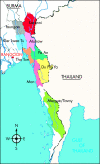Population-based survey methods to quantify associations between human rights violations and health outcomes among internally displaced persons in eastern Burma
- PMID: 17873229
- PMCID: PMC2652972
- DOI: 10.1136/jech.2006.055087
Population-based survey methods to quantify associations between human rights violations and health outcomes among internally displaced persons in eastern Burma
Abstract
Background: Case reports of human rights violations have focused on individuals' experiences. Population-based quantification of associations between rights indicators and health outcomes is rare and has not been documented in eastern Burma.
Objective: We describe the association between mortality and morbidity and the household-level experience of human rights violations among internally displaced persons in eastern Burma.
Methods: Mobile health workers in conflict zones of eastern Burma conducted 1834 retrospective household surveys in 2004. Workers recorded data on vital events, mid-upper arm circumference of young children, malaria parasitaemia status of respondents and household experience of various human rights violations during the previous 12 months.
Results: Under-5 mortality was 218 (95% confidence interval 135 to 301) per 1000 live births. Almost one-third of households reported forced labour (32.6%). Forced displacement (8.9% of households) was associated with increased child mortality (odds ratio = 2.80), child malnutrition (odds ratio = 3.22) and landmine injury (odds ratio = 3.89). Theft or destruction of the food supply (reported by 25.2% of households) was associated with increased crude mortality (odds ratio = 1.58), malaria parasitaemia (odds ratio = 1.82), child malnutrition (odds ratio = 1.94) and landmine injury (odds ratio = 4.55). Multiple rights violations (14.4% of households) increased the risk of child (incidence rate ratio = 2.18) and crude (incidence rate ratio = 1.75) mortality and the odds of landmine injury (odds ratio = 19.8). Child mortality risk was increased more than fivefold (incidence rate ratio = 5.23) among families reporting three or more rights violations.
Conclusions: Widespread human rights violations in conflict zones in eastern Burma are associated with significantly increased morbidity and mortality. Population-level associations can be quantified using standard epidemiological methods. This approach requires further validation and refinement elsewhere.
Conflict of interest statement
Competing interests: None.
References
-
- Spiegel P B, Salama P. War and mortality in Kosovo, 1998–99: an epidemiological testimony. Lancet 20003552204–2209. - PubMed
MeSH terms
LinkOut - more resources
Full Text Sources

